Luxury Jewelry Market Overview, 2031
The global luxury jewelry market size was valued at $21,751.6 million in 2021, and is projected to reach $40,190.7 million by 2031, registering a CAGR of 6.4% from 2022 to 2031. The necklaces segment was the highest revenue contributor to the market, and is estimated to reach $9,895.7 million by 2031, with a CAGR of 5.9%. Luxury jewelry involves creation of jewelry using precious stones or metals. Jewelry manufacturing involves jewelry design, mold, polish, cast, and plating of metal such as gold, silver, or platinum. Luxury jewelry and timepieces include rings, bracelets, earrings, cufflinks, tie clips, watches, necklaces, and hair pieces.
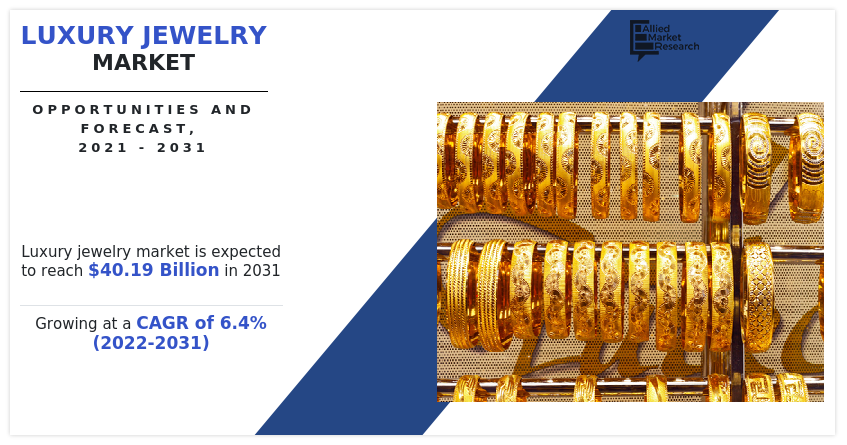
The luxury jewelry market is segmented into Product Type, Application and Distribution Channel.
Manufacturers are changing their product branding and advertising strategies to accelerate their sales across various countries. Innovative strategies such as new product launches with natural looking semi-precious stones, bold jewelry designs, and colorful stones engraved in the chains, which are packaged beautifully have been adopted by the manufacturing companies to increase the sales of luxury jewelry. Use of copper and brass as raw materials for manufacturing these products, which do not have any adverse effect on the skin, is a popular strategy of manufacturers to attract more customers. This has further helped in increasing the revenue of companies operating in this industry. Collectively, all the strategies adopted by the manufacturers are driving the growth of the luxury jewelry market.
Online retail platform is the major driver for the luxury jewelry market. Presently, numerous retailers are associating or have their own web-based retail stores where consumers can gain information about manufacturers and their products. Increase has been witnessed in the number of online shoppers, owing to availability of varied product options and price comparison on online shopping sites. This is useful for retailers due to zero expenditure on physical outlets or stores. One of the major reasons behind consumers preferring online shopping online is that consumers can read reviews provided by other users, and compare various stores, products, and the price by different sellers. Furthermore, increase in e-commerce sales, improvement in logistics services, ease in payment options, and the facility to enter into new international markets by major brands significantly contribute toward the growth of the global luxury jewelry market.
With improving lifestyle standards in several countries, consumers are inclined toward automated products designs such as 3D designed jewelry designs. Necklace designs and customized pendant designs fall in this category. Automation allows consumer to customize their jewelry according to their requirements. In addition, automation provides proper finishing to the product than traditional process of manual process. Furthermore, the manufacturing final cost is reduced, due to automation. Moreover, surge in demand for personalized jewelry designs has fueled the sales of these products.
The global luxury jewelry market is segmented into product type, application, distribution channel, and region. On the basis of product type, the luxury jewelry market is classified into necklaces, rings, earrings, bracelets, and others. By application, it is bifurcated into men, women and children. As per distribution channel, it is categorized into online and offline. Region wise, it is analyzed across North America (the U.S., Canada, and Mexico), Europe (Germany, UK, Italy, Spain, France, and the rest of Europe), Asia-Pacific (China, Japan, India, Australia, South Korea, and the rest of Asia-Pacific), and LAMEA (Brazil, Argentina, South Africa, United Arab Emirates, Saudi Arabia, and the rest of LAMEA).
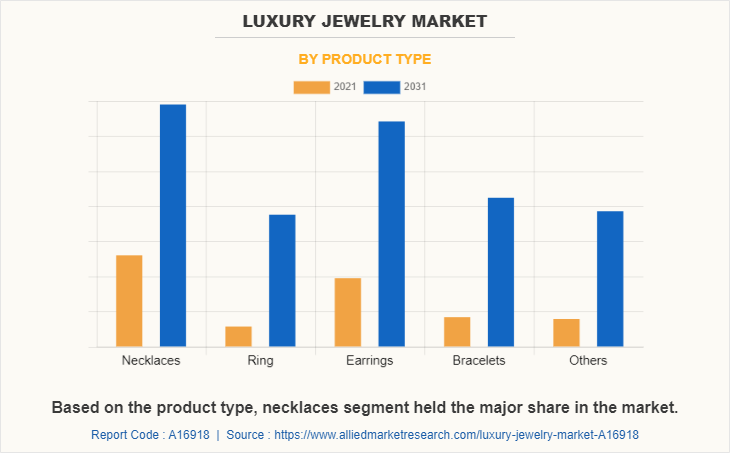
Based on product type, necklaces segment held the major Luxury Jewelry Market Share. Surge in prices of gold and silver is expected to create opportunities for artificial necklaces & chains in the market. In addition, young working women opt for jewelry that is modern, easy-to-wear, and can be easily teamed up with western wear, which fuels the luxury jewelry market growth. However, high price of gold jewelry has changed the customer preference from fine necklaces to relatively inexpensive and flashy luxury jewelry, especially during festivals and weddings. Necklaces made of non-precious metals fall into the lower price group, whereas semi-precious metals and stones fall into middle to high price products.
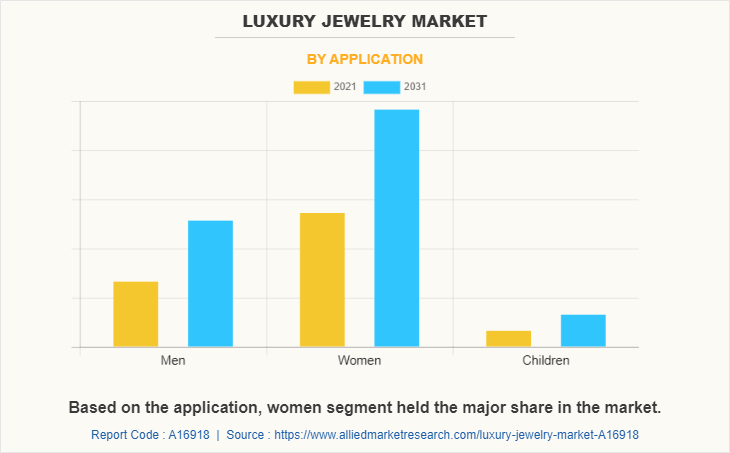
Based on application, women segment held the major share in the luxury jewelry market. Increase in focus of female consumers toward lightweight luxury jewelry from high-end gold and diamond jewelry and rise in spending capacity supported by working women population supplement the demand for luxury jewelry. Superior quality, comfort, and varieties in designs offered by these jewelry manufacturers attract customers to purchase luxury fashion accessories and jewelry, thereby augmenting the growth of the Luxury Jewelry Industry.
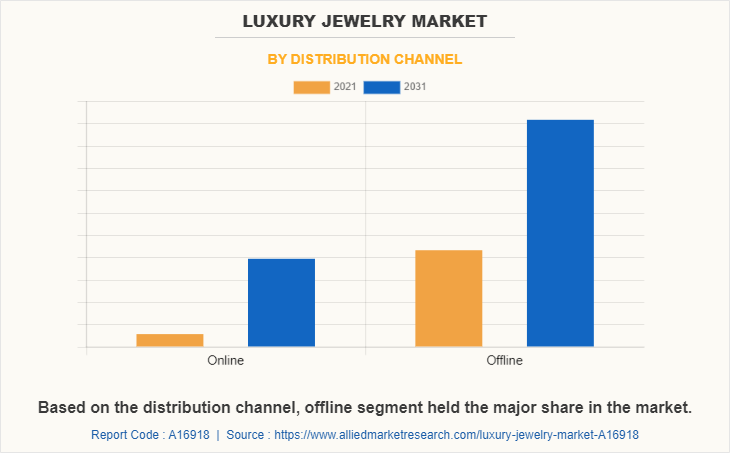
Based on distribution channel, offline segment held the major share in the luxury jewelry market. Increased consumer interest toward artificial and luxury jewelry is the prime factor that fuels the luxury jewelry market. In the recent past, a systematic change has been observed in the pattern of distribution channel such as specialty stores, which have expanded across the globe. In addition, operating players in the market are expanding the number of concept stores to increase their market reach. Furthermore, value-added services such as customer care services are projected to open up numerous market opportunities for players operating in the region.
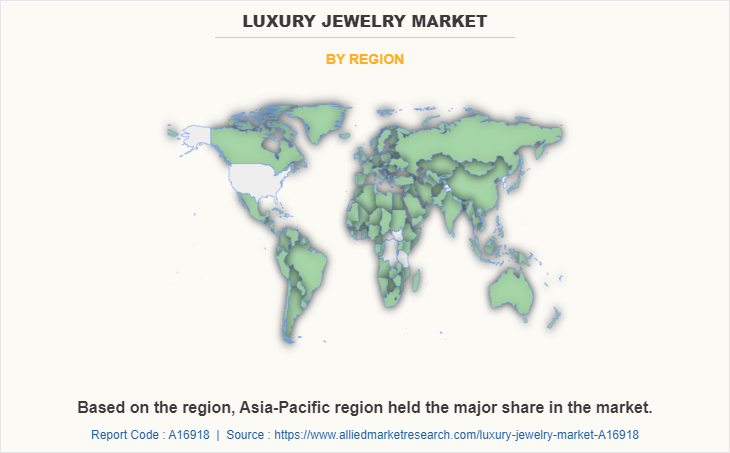
By region, Asia-Pacific registers the fastest growth in the luxury jewelry market and is is likely to remain same throughout the luxury jewelry market forecast period. This is attributed to the fact that consumers are expected to continue being image-conscious due to influence from beauty shows, TV shows, and magazines in various Asia-Pacific countries. Furthermore, increase in awareness regarding affordable jewelry designs, inclination toward western culture, and expansion of the luxury jewelry segment in tier 2 cities have led to wide acceptance of luxury jewelry, thus driving the growth of the luxury jewelry market. In addition, manufacturers of semi-precious jewelry have focused on expanding their presence in the region, owing to the fact that Asia-Pacific possesses high growth potential due to improvement in economic conditions in most of countries, rise in living standards, and increase in need to enhance physical appearance.
The key players profiled in the report include are Avon Products Inc., Chopard International SA, Giorgio Armani S.p.A, GRAFF, Guccio Gucci S.p.A., LVMH, MIKIMOTO, Pandora Jewelry, LLC, Prada S.p.A, Signet Jewelers Limited, Sukkhi Fashion Jewelry, Swarovski Group, Tanishq, Tribe Amrapali, and Youbella.
Key Benefits For Stakeholders
- This report provides a quantitative analysis of the market segments, current trends, estimations, and dynamics of the luxury jewelry market analysis from 2021 to 2031 to identify the prevailing luxury jewelry market opportunities.
- The luxury jewelry market research is offered along with information related to key drivers, restraints, and opportunities.
- Porter's five forces analysis highlights the potency of buyers and suppliers to enable stakeholders make profit-oriented business decisions and strengthen their supplier-buyer network.
- In-depth analysis of the luxury jewelry market segmentation assists to determine the prevailing luxury jewelry market opportunities.
- Major countries in each region are mapped according to their revenue contribution to the global luxury jewelry market.
- Market player positioning facilitates benchmarking and provides a clear understanding of the present position of the market players.
- The report includes the analysis of the regional as well as global luxury jewelry market trends, key players, market segments, application areas, and market growth strategies.
Luxury Jewelry Market Report Highlights
| Aspects | Details |
| By Product Type |
|
| By Application |
|
| By Distribution Channel |
|
| By Region |
|
| Key Market Players | Chopard International SA, MIKIMOTO, Prada S.p.A, Tanishq, Tribe Amrapali, Giorgio Armani S.p.A, Swarovski Group, LVMH, Avon Products Inc, Signet Jewelers Limited, GRAFF, Sukkhi Fashion Jewelry, Guccio Gucci S.p.A, Youbella |
Analyst Review
The global luxury jewelry market has been growing steadily over the past few years. Hence, manufacturers are introducing innovative designs to sustain in the competitive and dynamic market. The luxury jewelry market in developed countries such as the U.S., Canada, UK, and Italy, and is expected to exhibit a slow growth as compared to developing regions. In countries such as India, China, South Africa, and the Brazil, the luxury jewelry market possesses high growth potential. With the maturity of the North American and European markets, especially for products such as necklaces and earrings, manufacturers have focused on the Asian countries, such as India and China to expand their foothold. In countries such as India, non-branded products have a larger share as compared to branded products. Most of the companies have shifted their production plants to China and other Asia-Pacific countries to cut down the manufacturing costs.
Use of inexpensive raw materials such as brass, glass, wood, and plastic in artificial and luxury jewelry is expected to lower the prices of jewelries, thereby driving the growth of the luxury jewelry market globally. The industry has recently observed an emerging trend of men using luxury jewelry products in their daily lives. Use of luxury jewelries such as bracelets and rings by men could eventually increase, which, in turn, is expected to supplement the growth of the global luxury jewelry market. Moreover, online portals are becoming a popular medium to buy jewelry items among youths, and are anticipated to serve as the potential medium of sale for luxury jewelry in the coming years
Changes in lifestyle, rise in disposable income, an increase in the price of precious metal jewelry, an increase in fashion consciousness, and variations in packaging styles and appealing marketing strategies are the upcoming trends of Luxury Jewelry Market in the world.
Women is the leading application of the Luxury Jewelry Market
Asia-Pacific is the largest regional for Luxury Jewelry Market
The global luxury jewelry market was valued at $21,751.6 million in 2021, and is projected to reach $40,190.7 million by 2031, registering a CAGR of 6.4% from 2022 to 2031.
The major key players in the luxury jewelry market include Avon Products Inc., Chopard International SA, Giorgio Armani S.p.A, GRAFF, Guccio Gucci S.p.A., LVMH, MIKIMOTO, Pandora Jewelry, LLC, Prada S.p.A, Signet Jewelers Limited, Sukkhi Fashion Jewelry, Swarovski Group, Tanishq, Tribe Amrapali, and Youbella.
Loading Table Of Content...


